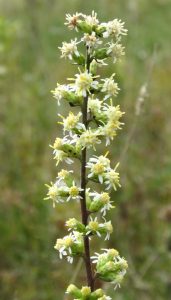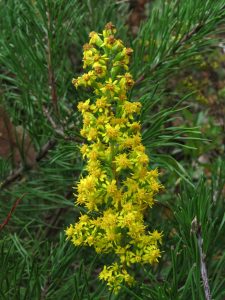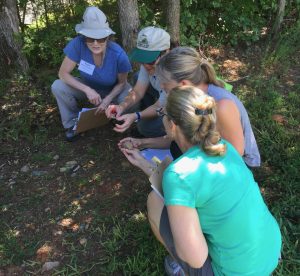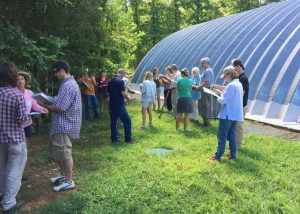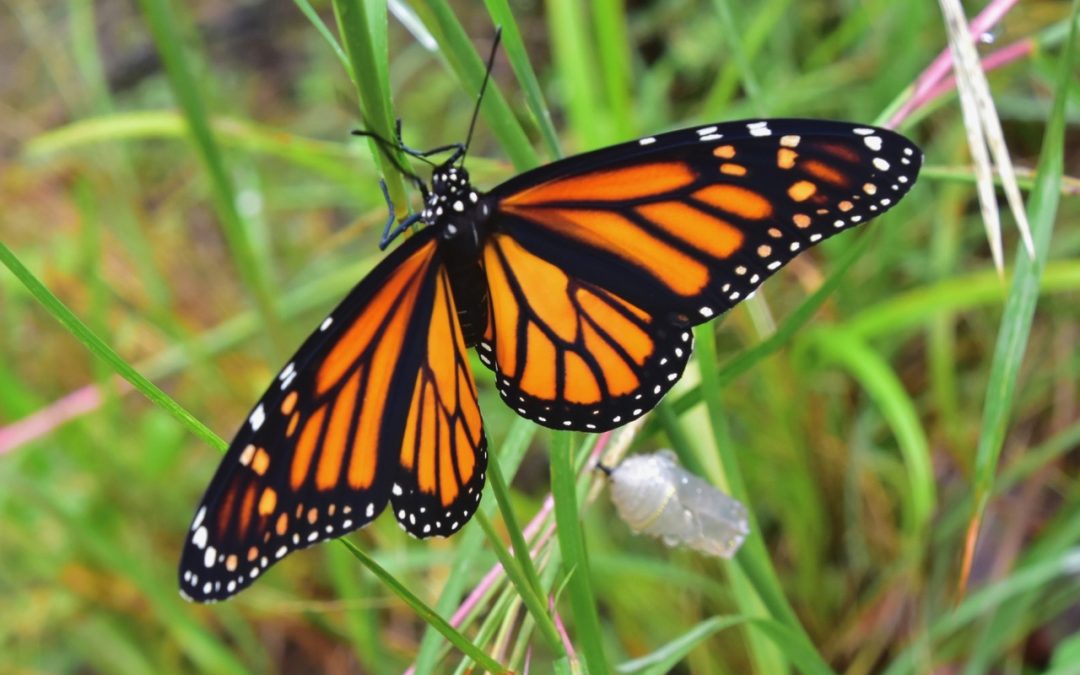
Sep 16, 2018
Last weekend, a few days after a weeding party spotted Monarch butterfly caterpillars in the Visitor Center’s Demonstration Garden, four chrysalises showed up attached to bluestem grasses and boneset.
Between showers this afternoon, we checked on them. One had apparently flown, leaving behind a ragged shell. Two were slowly drying and trying their wings in the mist. One has yet to emerge, but through the case, we can see the faintest stripes, which means it won’t be long.

The pupa seems entirely too small to contain all that butterfly—as if the metamorphosis were not enough of a miracle. Note the very faint lines visible through this one.
Next, a newly hatched monarch just out and still drying its wings.
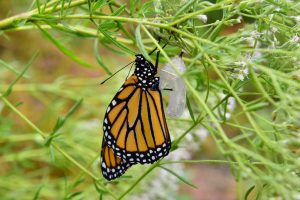
Thrilling to see them, and to know their plan. Unlike the season’s previous three generations, which live no more than six weeks, these butterflies will migrate—up to 3,000 miles—to warmer climates and live for six to eight months until time to come north again.
In an earlier stage, before pupation, they were caterpillars, like this one.
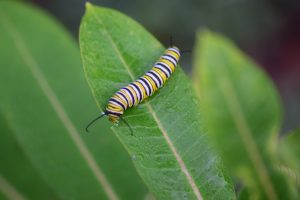
The caterpillar is a voracious eater capable of consuming an entire common milkweed leaf in less than five minutes. In the process they gain a poisonous defense against vertebrate predators such as frogs and birds. (This one was in the house garden last year, but succumbed to a praying mantis, against whom its defenses were ineffective.)
Here is the scene, the garden at the side of the Visitor Center near the loop road, where the monarchs emerged.
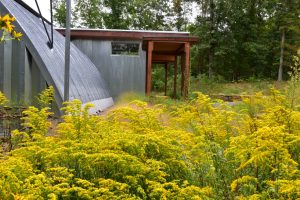
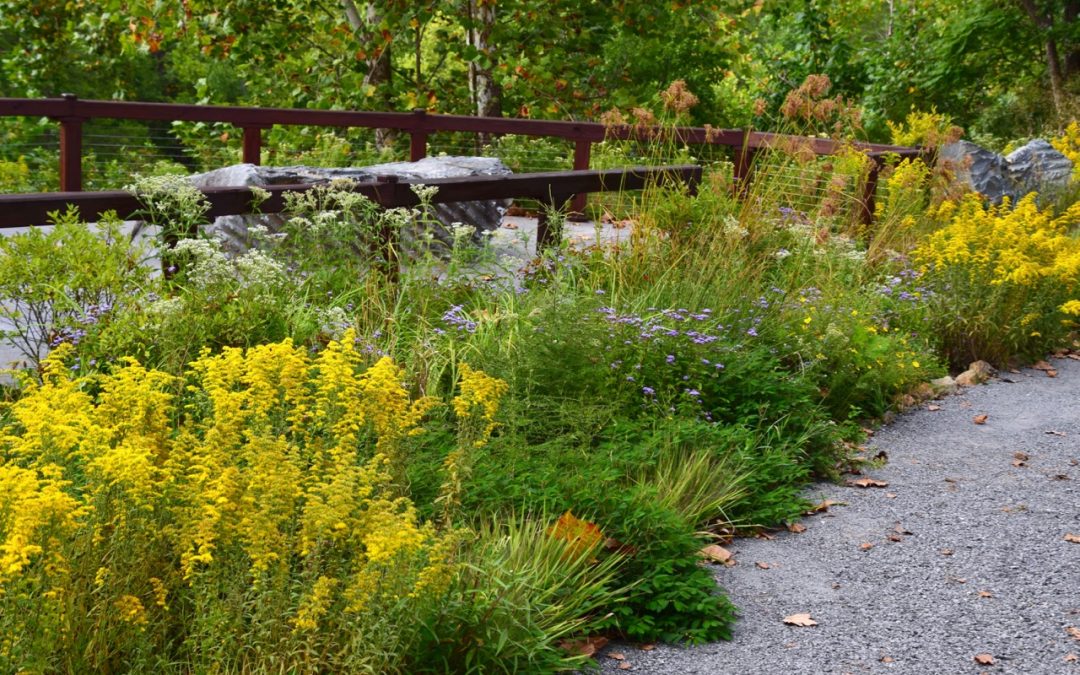
Aug 30, 2018
Fourteen species of Goldenrod grow at The Quarry Gardens, and most of them are blooming right about now. The featured image pictures a fine show of Gray goldenrod along the road at the quarry overlook platform.
North America is the world’s center for goldenrods with about 100 native species. Not surprisingly for such a large family of similar plants, they can be difficult to distinguish. In a timely move, Devin Floyd and Drew Chaney, of the Center for Urban Habitats, have created a user-friendly key to identifying those at the Quarry Gardens. Their key clusters the 14 species into five groups based on the shapes of their flower heads, and then goes into the details of leaf shape, stem hairiness, etc., each ending with a positive identification of one of these:
Stiff goldenrod, Solidago rigida Silverrod, Solidago bicolor
Downy goldenrod, Solidago puberula Slender goldenrod, Solidago erecta
Showy goldenrod, Solidago speciosa Gray goldenrod, Solidago nemoralis
Pineywoods goldenrod, Solidago pinetorum Early goldenrod, Solidago juncea
Blue-stemmed goldenrod, Solidago caesia Zig-zag goldenrod, Solidago flexicaulis
Sweet goldenrod, Solidago odora Late goldenrod, Solidago gigantea
Tall goldenrod, Solidago altissima Canada goldenrod, Solidago canadensis
The key may be found printed at the QG’s Visitor Center, or here: Key to the Goldenrods (Solidago) of Quarry Gardens Not being especially skilled (or patient) with dichotomous keys, we’re still mystified by several of these, but here are photos of some easy ones:
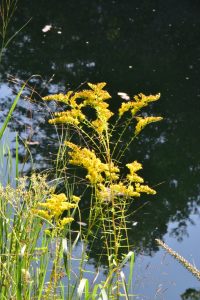
Sweet goldenrod has leaves that smell like anise. It may be found in the meadow by the Visitor Center and the North Quarry waterside pollinator patch, among other places.
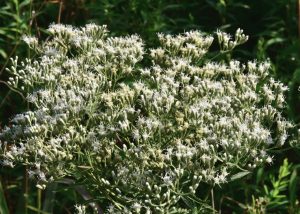
Silverrod might fool you you didn’t know that there is one white-flowering species of goldenrod. It may be found along the pine needle pathway to the overlook platform.
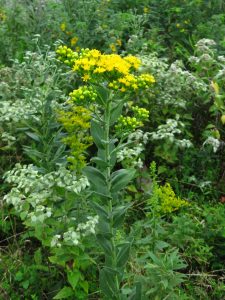
Stiff goldenrod may be found in the Demonstration garden by the Visitor Center.
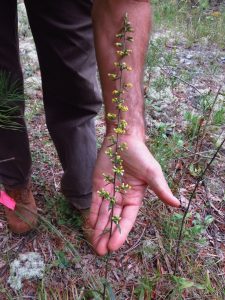
Devin found this Slender goldenrod along the road by the South Quarry.
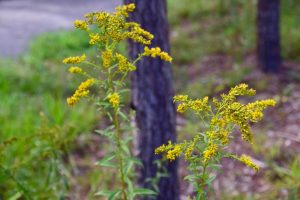
Pineywoods goldenrod volunteered—where else?—in the pinewoods along the path from the Visitor Center to the quarry overlook.
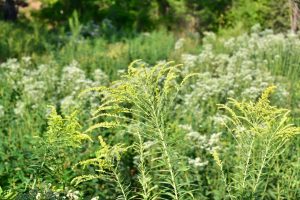
Showy goldenrod frames a view of the prairie that now covers the site of the first (middle) quarry. It is also among the 69 species planted or seeded into that prairie.
A few facts about Goldenrods:
- They are a food and nectar source for many insects.
- Their pollen does not cause hay fever; the culprit is ragweed, which blooms at the same time. Goldenrod has been used medicinally to reduceallergy symptoms.
- All are members of the Aster family, short-day plants that bloom in late summer.
- Thomas Edison, experimenting to extract the maximum amount of rubber from goldenrod, produced a 12-foot tall plant that was 12% rubber. The tires on the Model T Ford given to him by his friend Henry Ford were made of rubber from goldenrod.
- The young leaves are edible, and the plant has had some uses in traditional medicine for kidney ailments.
- The name Solidagomeans to make whole or heal.
- Cluster galls are a species indicator as they are found only on Canada goldenrod.
Addendum, 9/16/18
In spite of Devin’s key, which I (Bernice) didn’t read carefully enough, I misidentified two goldenrods in the previous blog. The one I called silverrod is actually boneset. Here are his photos of Silverrod, Solidago bicolor,
and Showy goldenrod, solidago speciosa.
Mea culpa.
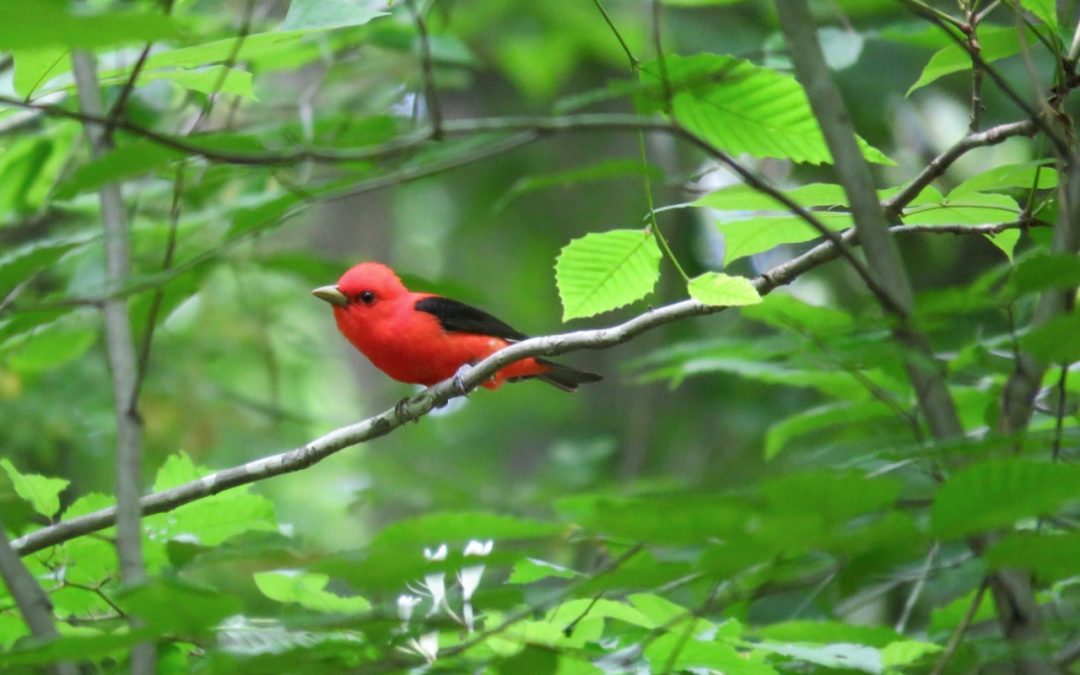
Aug 13, 2018
Ezra and Theo Staengl know birds. They also know the Quarry Gardens, having walked here often and supplied images and text for the Visitor Center’s digital photo exhibit Birds of the Quarry Gardens. Here they are (at another site).
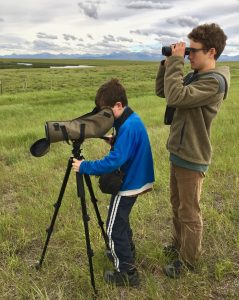
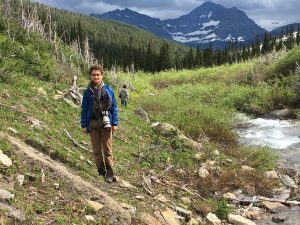
So far, our 40-acre site has yielded sightings of 75 species, including the Scarlet Tanager in the featured photo, and the Indigo Bunting, below.
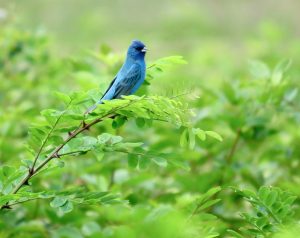
On Thursday, September 13, Ezra will lead a two-hour walk to observe year-round and early fall migrating birds, starting at 7:30 a.m. at the Visitor Center. To join him, sign up online at quarrygardensatschuyler.org/visit. The event is limited to 12 participants.
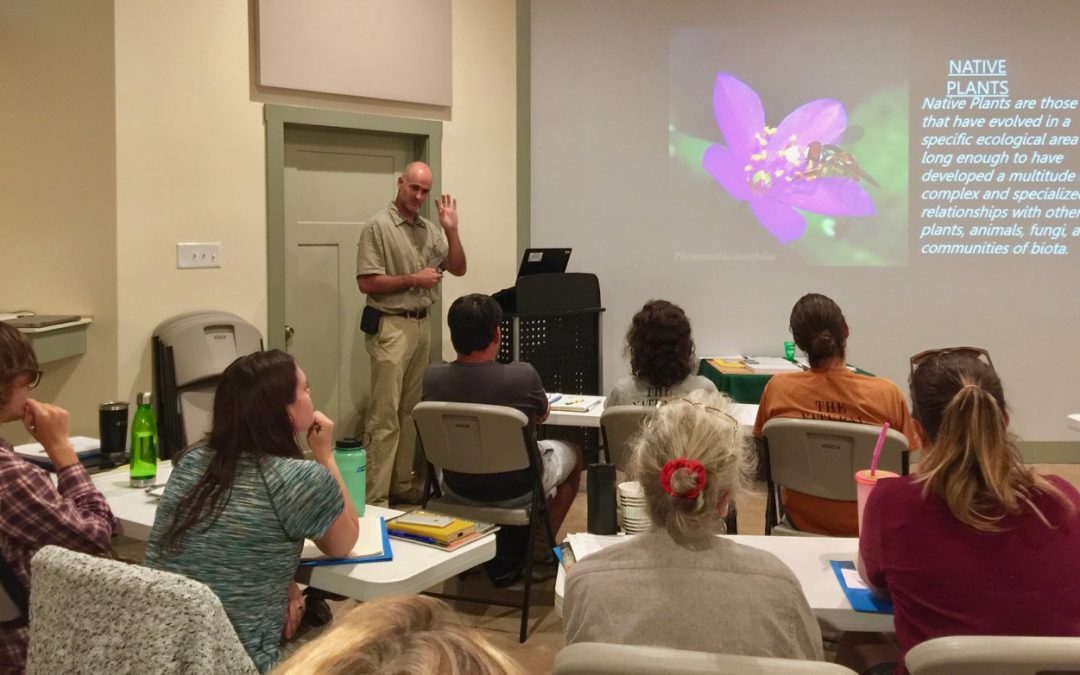
Jul 24, 2018
A beautiful day last Wednesday at the Quarry Gardens for a continuing education workshop on Ecosystem Modeling, sponsored by the Virginia Department of Game and Inland Fisheries (DGIF) and led by Devin Floyd of the Center for Urban Habitats (CUH).
The 25 landscape professionals in attendance came mostly from Virginia but also from parts of Maryland. Representing various specialties related to landscape design and management, they spent much of the day working in multidisciplinary teams. The three people standing are helpers with online research (l to r) Carol Heiser, DGIF; Rachel Bush, CUH; Devin Floyd, CUH.
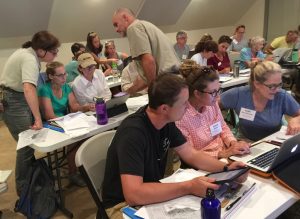
At the confluence of three Virginia ecoregions and a river, including areas both disturbed and undisturbed, the QGs site presents a wide spectrum of ecosystems. The day’s theme—Using Natural plant Communities as Models for Landscape Design—took participants from the Visitor Center’s classroom outside to analyze a disturbed site back of the Quonset hut, to find indicator plants in old forest remnants near the parking area, and to see a newly established prairie thriving over a former dump site. In these settings, they were able to observe and try the research methods of ecosystem discovery and modeling, and to see its benefits. Here are two photos of members of the group finding clues in rocks, soil, and plants in a recently disturbed area back of the Visitor Center:
A few even had energy left at the end of the day to walk the main trail and see the quarries! We were happy to host the day, and hope that the QGs might be the inspiration and location for many more such educational events.
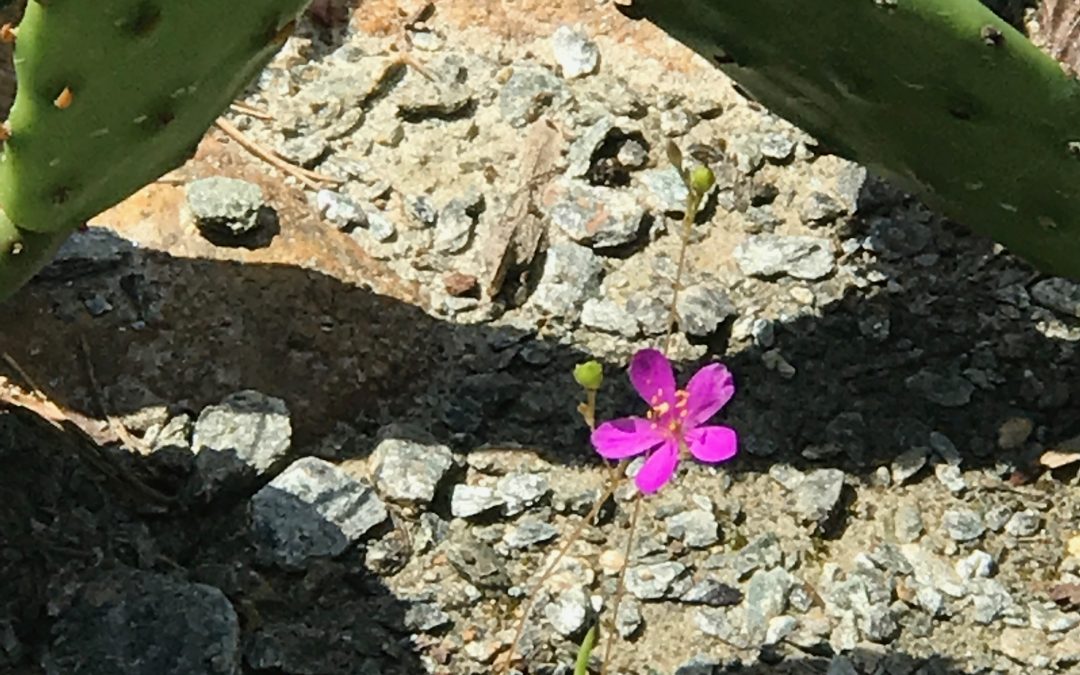
Jul 5, 2018
The two topics of this week’s blog are the ephemeral Quill fameflower and the much more durable Great Stone Head. Ephemeral first: The Quill fameflower (Phemeranthus teretifolius) is a member of the Portalacacae family (and one of the eighteen varieties of Miner’s lettuce). It is one of my favorite flowers at the Quarry Gardens. We have it in two places, growing in dents in the asphalt patch at the start of the tour where is also found the Eastern prickly pear cactus, and on top of the sitting rock at the overlook platform where it grows in ¼ inch of gravel in a slight depression. From its portulaca-like basal leaves, it sends up slender stalks that top off in insignificant buds of brown, green, or fuchsia.
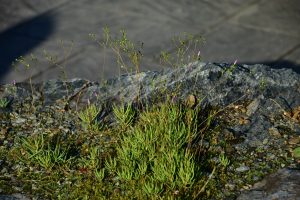
Then, on some sunny afternoon, one or more of those buds will blossom into a gorgeous little red-purple flower ¾ of an inch across that will last for only a couple of hours, its entire life cycle. The blossoms are so ephemeral that they have to be self-pollinating (although they are sometimes visited by opportunistic tiny bees), and unlike the great majority of native plants, have no known medicinal or nutritive use. One day I managed to catch a bunch of them blooming at once, a rare sight. Here are those I found on the sitting rock.
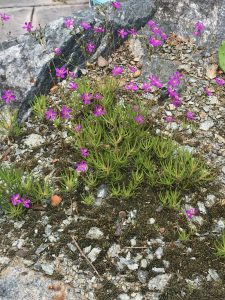
Here are others in the asphalt by the prickly pears.
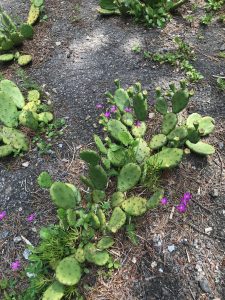
Second subject: The Great Stone Head. A few months ago Bernice and I toured the Alberene Soapstone plant here in Schuyler, now a part of Polycor, Inc., a Canadian firm that also owns Georgia Marble Company where Schuyler soapstone is now processed into (mostly) kitchen countertops. In front of one of the industrial buildings was laying, almost out of sight, a slightly larger than life-sized stone head roughly carved out of soapstone. I asked about its provenance, and was told no one really knew. I suggested to Chadd Minor, the quarry foreman, that if the company ever decided to get rid of it, I would admire to have it for the Quarry Gardens. A few weeks later it arrived, along with its base, at our Visitors Center. Although deceptively heavy (upwards of 400 pounds), Frankie and Warren Graves managed to manhandle it to its new location at the last overlook of the north quarry pool, where, in my view, it looks great.
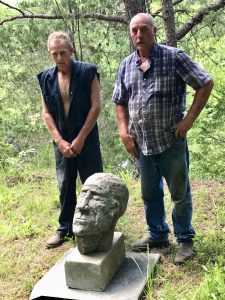
Chadd said he’d try to find out something about its history, but for the moment, it’s still an intriguing mystery.
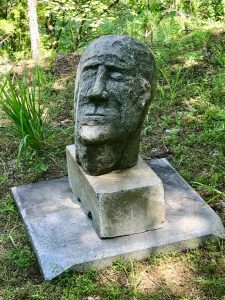
Bernice feels that from some angles, the jutting chin makes him look like FDR, and threatens to give him a cigarette in a holder.












